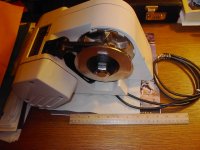jennykatz-
I'll let others tell you about how to handle the waranty issues, but will give you some suggestions on the windlass use.
The distance from your batteries in the stern up to the helm and to the windlass probably approaches 50 feet, roundtrip.
It's very important to use large enough wire to keep the voltage drop reasonable.
Your S/L Spring 400 has a 400 watt motor in it. To get 400 watts at 12 volts, you have to draw 33 amps (12 v x 33 amps = 400 watts). You probably have a 40 or even a 50 amp circuit breaker in the system. The motor can draw a lot of amps when it stalls out or is heavily loaded!
According to the wire usage tables in the W/M catalogue (p.552, 2006 ed.), a draw of 40 amps with a round trip of 50 feet needs a gauge 6 wire to carry the load with a 10% drop in voltage. The resistance of 10 gauge wire is two and a half that of a 6 gauge.
What happens when a too small gauge wire is used , is that the resistance drops the supplied voltage to the motor/appliance/ or electronic device.
The decrease in voltage means that the motor has to draw more amperage to do the work. More amps at lesser voltage means more of the energy is lost into heat in the coils and armature of the motor.
Another way to say this is this: Higher voltages have a greater push to overcome the internal resistance of the motor, and with additionally, they also create stronger magnetic fields, which makes the motor's use of energy more efficient. The resistance becomes less of a factor, and less of the energy is wasted on creating heat in the motor's wiring.
So if the supplied voltage is too low, the motor pulls excessive amperage and overheats as a result.
Motors like the windlass and engine starting motors, when overheated, frequently melt the solder in the armature's commutator, throw windings, or melt the wiring. Too much heat can kill any motor.
I'm not sure that this is what happened to your windlass motors, but it's something to consider.
Funny enough, the windlass often comes with fairly small gauge wiring itself. As long as the battery is close, no problem! But put it 25 x 2 feet away, and one ought to get out some big stuff!
I have a Simpson/Lawrence Horizon Express on the table behind me with a 1000 watt motor, and with 6 gauge wire coming out of it. If I install it in my Sea Ray, I'll have to use 2 gauge wire, which is regular battery cable sized!
Hope this helps!
Joe.


